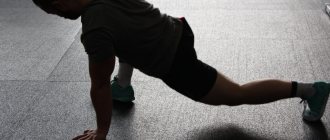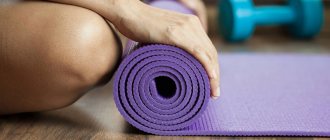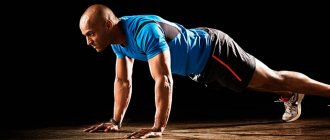Everyone knows that the most important component of a healthy lifestyle is physical exercise. Running is considered the simplest, most accessible and effective way to keep yourself in great shape. But not everyone knows that the desired effect can be achieved only with strict adherence to certain rules. In order for running training to bring maximum benefits, a proper warm-up must be organized before running.
How to prepare for the load?
Starting a run without warming up can be compared to starting a racing car without warming up the engine. In addition, lack of preparation can lead to various injuries and reduce the effectiveness of the running load. Warming up before running can take about 5-10 minutes, this will help increase the range of motion and increase muscle productivity, and the body will respond better to physical activity.
Usually the warm-up is done from top to bottom, although the order of the exercises is not fundamental. It is better to start your warm-up by walking in place; it will help warm up your body. Then you can move on to joint exercises and a series of exercises to stretch the muscles.
IMPORTANT! At the end of the warm-up, you can perform intense cardio exercises and summarize by restoring your breathing, that is, taking a deep breath and exhaling.
Warm-up consists of the following exercises:
- Walking in place may take about 1 minute.
- Joint gymnastics is aimed at activating the work of joints, ligaments and tendons. This complex may include movements of the head, shoulders, rotation of the arms, feet and other joint groups. This part of the warm-up usually takes about 2-3 minutes.
- Then you should move on to dynamic stretching, which involves tilting the body in different directions, circular rotations of the pelvis, bending forward, lunges with rolls and other exercises aimed at warming up and stretching the muscles. Stretching also takes about 2-3 minutes.
- Cardio warm-up may include exercises such as jumping rope, walking or running in place with your knees high, and jumping jacks. This warm-up phase will take approximately 2 minutes.
ATTENTION! The warm-up should be completed by restoring your breathing, inhaling and exhaling for about 30 seconds. This can be done by bending or squatting, raising your arms as you inhale and lowering them as you exhale.
Simple and effective complex
If you think that before jogging it is enough to warm up your legs before running, you are very mistaken, because practically all muscle groups are involved in this type of sports activity. We will present a simple complex that is suitable for both beginner runners and experienced athletes. Spend 10-15 minutes on it before the start and you don’t have to worry about the health and quality of the lesson.
So, let’s remember our school physical education lessons and follow a similar pattern. The exercises are performed from top to bottom, from the neck to the feet, with the initial stance - feet shoulder-width apart, arms on your sides, back straight. Run:
- Circular movements of the neck and tilts of the head in 4 directions;
- Rotation of the shoulder and elbow joints. Start in a hands-on-shoulders position, then straighten your upper limbs;
- Next, knead your lower back, pelvis, and body - bending, circular rotation, flexion and extension;
- Get down lower - run in place, run with the shin overlapping backwards, make circular rotations of the ankle joints and knees.
- Perform exercises with raising your toes, squats, and jumping in place.
Please note that in this material we do not pay attention to the correct technique for performing the exercises, therefore, we recommend studying the relevant literature or watching educational video tutorials.
Warming up before running to lose weight should be done intensively and in two approaches, while during the second it is advisable to pick up dumbbells or increase the number of cycles. It has been proven that during the first 40 minutes of training, the body uses energy from glycogen stored in the liver, and only then begins to draw strength from fat. Therefore, the longer you spend warming up, the sooner you will speed up the process of burning excess weight while running.
Basic stretching exercises
In order to warm up, you can slowly run the first kilometer, or you can do a short warm-up. Stretching is considered one of the main stages of warming up and preparing muscles for running load. In this case, stretching can be both static and dynamic.
REFERENCE! In the warm-up, the second type of stretching is often used, which helps to stretch the muscles using a certain set of movements.
It is important to warm up exactly those muscle groups that are actively involved in running, that is, the thighs, calf muscles and quadriceps. Basic stretching exercises include:
- Pulling your knees to your chest will help stretch your hip joint and warm up your gluteal and piriformis muscles. To do this, you need to pull one knee to your chest, release it and take a step forward. Then you should change your leg, take it by the foot and knee, pull it to your chest, release it and take a step forward. You can perform 5 movements on each leg.
- Opening the hips helps stretch the deep muscles of the hips and thighs. To do this, you need to get into the starting position, bend your knee, raise it to the level of your hip and turn it 90 degrees outward, if necessary, you can help with your hands. Having released the knee, the same must be repeated with the second leg.
- Circular rotations with your arms should be performed with maximum amplitude and at a smooth pace. These movements can be done with each hand alternately or with both hands at the same time. They help warm up the deltoids and upper back. This part of the warm-up should be done for 30 seconds.
- Bends are performed from a starting position; they help stretch the deltoids and warm up the core and hamstrings. To do this, you need to bend over 10 times, touching your toes with your hands, your back should be straight, and your lunges should not be sudden.
- Lunges with rolls are performed from a position with legs wide apart. Standing straight, you need to transfer your body weight first to your right leg, bending it at the knee. Then you need to roll onto your left leg and sit in a deep lunge. You should stay on each leg for 5 seconds, while performing springy downward movements.
- Leg swings are aimed at warming up the hamstrings and are considered one of the basic warm-up exercises before running. You need to swing your leg forward, touching the toes of your raised leg with your outstretched arms. Having released the leg, the same should be repeated with the second.
Basic mistakes
Well, we have looked at all the nuances associated with the correct execution of the warm-up before running. Finally, check out the list of things not to do.
- The complex should not be too long, especially when warming up before running in winter. You already have serious physical activity ahead of you; you shouldn’t exhaust your body at the very beginning. The upper time ceiling is 20 minutes.
- Never start warming up with stretching - it is much better suited for a cool down. If you don’t understand the reason, try doing the splits right now, without prior warming up. Hurt?
- Leg swings, lunges and rolls from foot to foot are more suitable for evening warm-ups, but in the morning try not to stretch with exercises in which it is difficult to control the intensity. Remember, the body has not yet woken up, so it is most vulnerable.
Well, let's finish. Remember, any jogging, even light - even regular walking, should begin with a warm-up. Even chess players warm up! Also, don’t forget about the cool-down - start and finish classes correctly!
Special running exercises
Specific running exercises can be performed as a warm-up or instead of the main workout. They prepare ligaments and joints for running and coordinate the muscles of the legs. In addition, they are aimed at improving:
- Feelings of balance.
- Back positions.
- Breathing techniques.
- Correct foot placement.
- Feelings of rhythm.
- Ability to run in a straight line.
This complex includes 5-6 basic exercises that should be performed over a short distance with jogging between series:
- Running with shin sweeps is aimed at uniformly working the muscles of the back of the thighs. When running this way, you need to raise your shins so high that your heels touch your buttocks. It is important to follow the correct running technique and perform it on your toes.
- Running with high hips is done on your toes and helps warm up the front of your thighs. At the same time, you need to raise your knees high enough so that your thighs are parallel to the ground or higher. The back should remain straight and the body slightly tilted forward.
- Straight-legged running , in essence, is performed dynamically, but is static in relation to the muscles of the lower leg and thighs. When running this way, your legs should be straight, your toes should be extended, and your feet should be completely flat on the surface. You need to quickly push off the ground with your feet, and although this run is quite unusual, it helps to coordinate movements and train the whole body.
- Single leg lift means alternately lifting your legs while running. To do this, you need to lift your foot off the surface, bend your leg at the knee and pull it up to your buttock. Next, you should return to the starting position, take a couple of steps and repeat the same with the second leg.
- Jumps are performed with powerful kicks, while trying to seem to hang in the air. Jumps must be made at every step. They resemble jumping rope, but are performed moving forward. The main emphasis is on the muscles and ligaments of the ankle joint.
- Running sideways with side steps is performed with a leg raised to the side, and when the body weight is transferred to it, a jump is made and the second leg is placed. When running this way, many muscles of the feet work, since the runner does not land on his heels, and the gastrocnemius and soleus muscles are also worked out. With each step, the position of the hands changes towards and away from you.
- Deer running or multi-leaps is considered one of the most difficult exercises for amateur runners. In this case, it is important that both legs push off the ground; you need to imagine that with each step you are jumping over a hole. The arms should work as if they were running normally, but should be positioned wider and further away from the body. The front leg should bend toward the stomach, the knee bent at a 90-degree angle, and the back leg remaining straight.
- Running with jumping on one leg is performed on a straight leg, which plays the role of a push leg, and the supporting leg should be bent at the knee at a right angle. You need to push with your foot not in length, but in height, moving forward minimally.
- Uphill races of 70-100 meters are performed on a surface with a slight inclination angle. In this exercise, it is not the frequency and speed of running that plays an important role, but the width of the step. When running this way, special attention is paid to the work of the arms and pushing when moving.
Standard warm-up for a half marathon participant:
- slow running (at heart rate 130-140 beats/min) for 15-20 minutes;
- stretching exercises (ST) 5-10 minutes;
- special running exercises: 1 series of 5-7 exercises of 50 meters each with an intensity of 80%;
- acceleration 3-4 x 50-80 meters with an intensity of 80-90%;
- short rest of 3-4 minutes (often this time is spent going to the toilet);
- stretching in the starting corridor (if necessary, if the waiting time in the storage area exceeds 5 minutes).
Warm-up should not be unpleasant and hang like an anchor around your neck. It should bring pleasure and prepare you for the start mentally and physically. Do not forget that at the largest competitions, where the number of participants exceeds several thousand, the organizers line up the athletes in the starting corridor in advance, and as a result you can stand in the immediate starting area for more than 15 minutes. Keep this in mind when timing your warm-up.
Exercise options for warming up before a light run
The type of running is largely determined by the duration and content of the warm-up. When running short distances, the warm-up complex should include simple elements to develop flexibility. These include:
- swing your arms and legs;
- lunges and half-squats;
- bends;
- rotation of the head and body.
A minimal complex will perfectly warm up the muscles for a few minutes, give them elasticity and set them up for work. When performing a warm-up, you need to remember the following nuances:
- “no” to sudden movements;
- “yes” to your own feelings.
Gentle stretching will not cause damage to the muscles, and listening to yourself will allow you to stop one or another element in time if pain occurs.
Warm-up should be accompanied by proper breathing. It cannot be held; inhalation must be made deeply through the nose, and exhalation through the mouth.
What is the importance of warming up before running?
While running, the load on the spine, knee, hip joints, and heart increases. To prevent stress from becoming excessive for them, proper warm-up should not be neglected before running. It doesn't really matter whether you're going to run a cross-country race or just go for a short run around the house.
What does it have a beneficial effect on?
The warm-up complex before cross-country is of paramount importance:
- Increases the elasticity of the ligamentous apparatus, which prevents sprains and ligament tears;
- Warms up the muscles - they respond faster to signals from the nervous system and work more efficiently;
- Develops the correct motor stereotype, which allows you to avoid incorrect placement of the foot, leading to dislocations.
During the warm-up, it is important to combine different types of physical exercises and work not only the legs, but also the shoulder girdle and the entire body as a whole. This combination is necessary to activate the work of all muscle groups, because not only the muscles of the lower extremities are involved in running.
- Warming up the neck muscles promotes better shock absorption of the spine during movement and prevents compression of the vertebral arteries;
- Gymnastics for the trunk muscles stabilizes the body and reduces the load on the spinal column;
- Developing the hip joints improves blood supply to the lower extremities and prevents cramps;
- Exercises for the knee and hip joints improve the tolerance of axial load, prevent the development of osteoarthritis, and reduce the likelihood of dislocations;
- Jumping and squats are needed to cause fatigue in the quadriceps muscles of the thighs, so that during running the main load is transferred to the calf muscles;
- Stretching makes it possible to reduce compression of the vertebrae and joints with each step.
Quickly prepares the body and mind for exercise
It is necessary to prepare for training not only the musculoskeletal system, but also the internal organs and the brain:
- The correct breathing rhythm is established, it becomes deeper, more measured, the body is better saturated with oxygen;
- The heart gradually “gets used” to physical activity, the heart rate increases gradually;
- The brain's control over muscle work is activated, coordination of movements is improved, which reduces the risk of falls and injuries.
For our body, increased physical activity is stressful, so without special preparation, training can lead to the release of large amounts of stress hormones into the blood, disrupting the function of all organs and systems.
How to run properly in the evening - warm-up before bed
Morning jogging sounds great, it evokes respect for those who are able to put on a tracksuit in the morning and run along the streets that have not yet woken up, or along the paths of the park, meeting the dawn in motion.
However, there are many supporters of jogging in the evenings, who believe that there is nothing better than running after a working day spent mostly sitting at a desk.
What time of day is ideal for running is debatable; It’s best to choose the time that’s most suitable for you for jogging, otherwise the enthusiasm of a novice runner may not last long
In any case, it is important how to properly run in the evenings to bring the greatest benefit to the body.
How to get ready for an evening run
In such cases, many people come up with various excuses to postpone running until another day, but this usually leads to the fact that the person stops running altogether, or does it only occasionally.
How to get yourself ready for a run and ignore excuses for not wanting to go on the treadmill in the evening?
“I'm tired” is a common excuse for people who want to skip a run. Indeed, when the working day is left behind, the crush in crowded public transport or traffic jams, and also household chores - you just want to relax.
Give yourself 15-20 minutes to rest: do nothing, or do something enjoyable and effortless, such as listening to music or watching TV. At the same time, you must remember that in fifteen minutes you will have to get up, change clothes, and go for a run.
Important!
You can drink a small cup of coffee, eat a small chocolate bar or candy - they contain simple carbohydrates that will instantly give you energy, and you will quickly use up the calories that came into your body along with the treat on the treadmill.
And also remember that the best rest is a change of activity, which means you can also rest while jogging.
httpv://www.youtube.com/watch?v=embed/dI5yt9L9jV4
Housework, communication with your spouse, children, friends and relatives, going to restaurants and movies - all of this, of course, cannot be completely abandoned, but if you notice that you have less and less time for exercise, work on your schedule and Set aside time for jogging. After all, if you don't keep your body in good shape, having fun will become less and less enjoyable over time. Treat jogging like brushing your teeth - you shouldn't skip it simply because sooner or later it will have a bad effect on your health.
If you are afraid to run in the evenings
In this case, there are two options - either run in the morning or afternoon, or do everything possible to ensure your own safety: run along illuminated streets, always have a mobile phone with you, and so on. Below we will talk in more detail about safety during evening runs.
If you have no excuses
Just don't feel like running after work? Or do you not feel like running or doing any other sports at all? Tell yourself that you will only run in the evenings for three to four weeks, and during this time, do not avoid training under any circumstances.
Psychologists say that during this time a person develops new habits, which means that after about a month you will no longer have to persuade yourself to go for a run.
Another option: agree to run with a friend - it is advisable that he has been running for a long time and is not inclined to skip training. Experts say that it is much more difficult for people to refuse activities, even if not the most pleasant ones, that are somehow connected with other people.
There will still be moments of weakness, but you will feel embarrassed in front of your friend not to go for a run simply because you are tired or cannot plan your day so that there is time for exercise.
Recommendations for those who run in the evenings
What if you don’t warm up?
There are people who don't warm up. They do not get injured for the reason that their body has a good margin of safety. The problem is that once the mechanism has been worked out, it will still fail - injuries during strength exercises are high. So what can happen if you don't warm up?
At the very least, you will pull the ligaments. A common problem that will make you forget about training for a while. If the blood vessels are weak, you can easily faint. Sudden loads are fraught with pressure changes, and then it’s not far from unconsciousness. Warming up also affects the joints, or more precisely, the production of lubricating fluid. If you don’t warm up, you may have difficulties with them, and potentially you will have to give up the sport completely.
What is the warm-up for?
Having put together the above options for preparing the body before jogging, we can draw the following conclusions.
The main useful consequences of warming up (videos of any variations of which can be found in abundance on the World Wide Web) are:
- warming up muscle tissue and ligaments (which increases their elasticity and, therefore, reduces the likelihood of injury);
- increased blood circulation (leading to a better supply of oxygen to cells);
- acceleration of metabolism (which is especially important if you prefer morning jogging).
Indirect, but also important advantages of warming up (if you understand how to properly train and prepare the body for such training) should be called:
- psychological readiness for long-term physical activity;
- developing proper “running” breathing;
- better body control (which also promotes good coordination of movements and reduces the likelihood of falling or twisting a leg);
- readiness to stress the cardiovascular system (the best way to protect yourself from a stroke or heart attack in the future);
- absence of a sharp, stressful transition from low activity of the body to high activity;
- a longer period of intense metabolism, promoting the burning of excess fat;
- strengthening the muscle corset, which protects joints and ligaments from damage;
- increasing the effectiveness of classes in general.
How much time should you spend stretching? Theoretically, its duration should be proportional to the running time - however, there are some nuances here. Beginners are recommended to spend 1.5 times more time, since their body is less prepared. Their cardio usually lasts about 15 minutes. For professional athletes, 7-10 minutes is enough.










